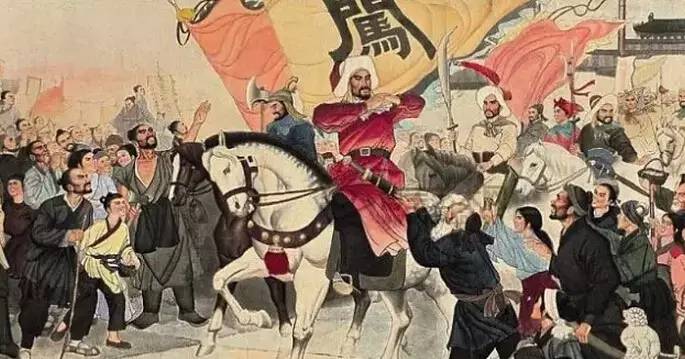明朝
Fall of the Ming Dynasty
明朝的灭亡
The fall of the Ming Dynasty was a protracted affair, its roots beginning as early as 1600 with the emergence of the Manchu under Nurhaci.
明朝的灭亡是一件长期的事情,它的覆灭早在1600年努尔哈赤统治的满族出现后就埋下了祸根。
Under the brilliant commander, Yuan Chonghuan, the Ming were able to repeatedly fight off the Manchus, notably in 1623 (where Nurhaci himself was killed by a much smaller force commanded by Yuan.) and in 1628.
在杰出的将领袁崇焕的带领下,明朝得以不断击退满族人,其中最著名的是1623年(努尔哈赤被比自己兵力少得多的袁军所杀)以及1628年。
But the tragic killing of General Yuan in 1630 by the futile Ming emperor began to change things around ; the succeeding general proved unable to eliminate the Manchu threat.
然而自从1630年袁江军被无能的明朝皇帝杀害后,一切都变了;继任的将军无法减少满族人的威胁。
Earlier, however, in Yuan’s command he had securely fortified the Shanhai Pass, thus blocking the Manchus from crossing the pass to attack Liaodong Peninsula.
早先,袁崇焕曾下令加固山海关的安全防御并因此阻挡了满族人入关攻打辽东半岛。
Unable to attack the heart of Ming directly, the Manchu instead bided their time, developing their own artillery and gathering allies.
因为无法直接攻打明朝的中心,满族人等候着,加强他们自己的炮兵并召集盟军。
They were able to enlist Ming government officials and generals as their strategic advisors.
他们能够招募明朝的官员和将领作为他们的军事参谋。
Large part of the Ming Army mutinied to the Manchu banner.
明朝军队的大部分人马向满族人倒戈。
In 1633 they completed a conquest of Inner Mongolia, resulting in a large scale recruitment of Mongol troops under the Manchu banner and the securing of an additional route into the Ming heartland.
1633年,满人征服了内蒙古,因此将蒙古的大部分兵力收归自己麾下,这是入侵明朝中心的另一个保障。
By 1636 the Manchu ruler Huangtaiji was confident enough to proclaim the Imperial Qing Dynasty at Shenyang, which had fallen to the Manchu in 1621, taking the Imperial title Chongde.
到1636年时,满族的领袖皇太极已经足够有自信在沈阳(1621年被满族政府)建立大清帝国,立年号为崇德。
The end of 1637 saw the defeat and conquest of Ming’s traditional ally Korea by a 100 000 strong Manchu army, and the Korean renunciation of the Ming Dynasty.
1637年年末见证了明朝的传统盟友韩国被拥有100000人马的强大的满军打败和政征服,最终韩国与明朝脱离了关系。
On May 26, 1644, Beijing fell to a rebel army led by Li Zicheng.
1644年5月26日,北京陷入由李自成领导的反叛军手中。

Seizing their chance, the Manchus crossed the Great Wall after Ming border general Wu Sangui opened the gates at Shanhai Pass, and quickly overthrew Li’s short-lived Shun Dynasty.
满族人抓住这个机会,在明朝将领吴三桂打开山海关的大门后进入了长城,很快就推翻了李自成建立的短命的顺王朝。
Despite the loss of Beijing (whose weakness as an Imperial capital had been foreseen by Zhu Yuanzhang) and the death of the Emperor, Ming power was by no means destroyed.
因为北京失守(朱元璋曾预见北京作为国都的弱点)和皇帝的驾崩,明朝毫无疑问地灭亡了。
Nanjing, Fujian, Guangdong, Shanxi and Yunnan could all have been and were in fact strongholds of Ming resistance.
南京、福建、广东和山西是明朝时期的要塞,然而中央政权的沦陷导致了许多明朝伪政权的出现,它们无法共存。
However, the loss of central authority saw multiple pretenders for the Ming throne, unable to work together.
这些政权被清军各个击破,直到1662年,永历皇帝朱由榔去世后,明朝复兴的最后一丝希望破灭了。
Each bastion of resistance was individually defeated by the Qing until 1662, when the last real hopes of a Ming revival died with the Yongli emperor, Zhu Youlang.
尽管明朝战败,到中华民国成立以前仍然有许多小规模的反清复明运动。
Despite the Ming defeat, smaller loyalist movements continued till the proclamation of the Republic Of China.


